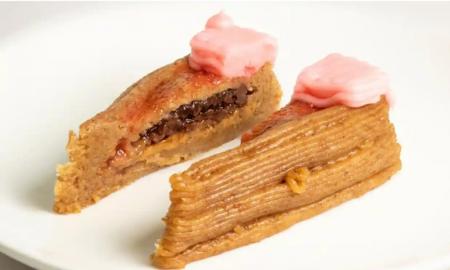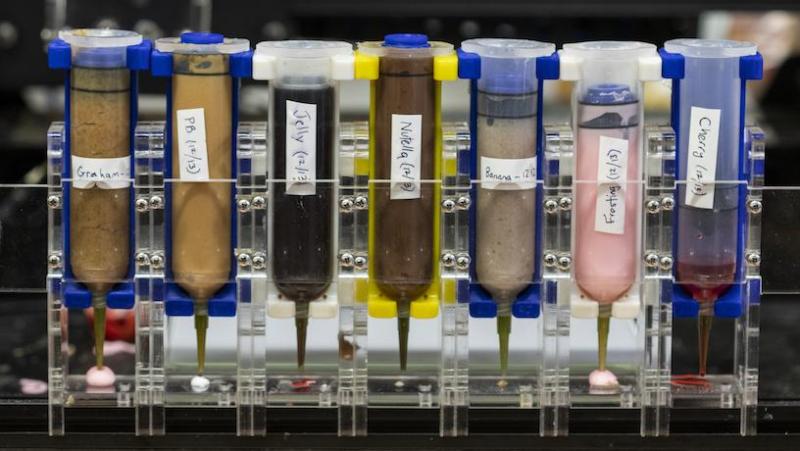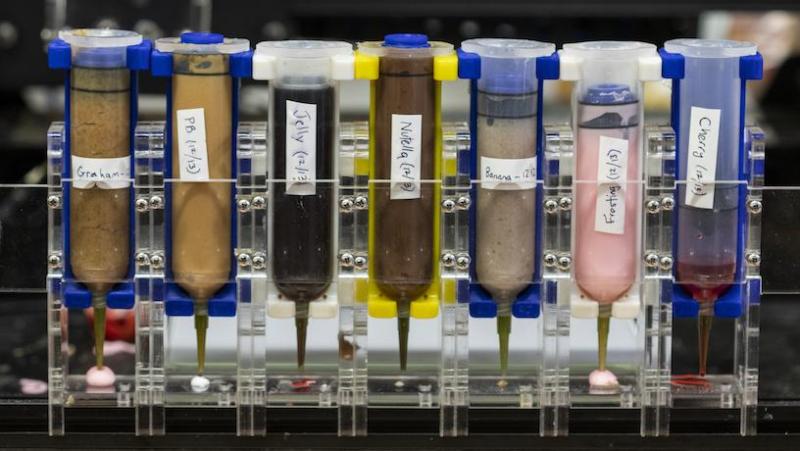
Image credit: Jonathan Blutinger / Columbia Engineering
Just when you think you have seen it all, you see something like this. They are printing cakes now. Do those words mean what they traditionally meant? – you are forced to wonder. But yes, they are 3D-printing cakes that apparently taste pretty sweet.
Researchers at Columbia University have been working on printed food for years and were finally able to print a cheesecake (the best cake there is, don’t fight me on this) that looks and tastes good.
However, this time around they worked with cooked ingredients as opposed to uncooked ingredients as most 3D-printed food research has been trying. For the cheesecake, they used 7 ingredients – graham crackers (a dry biscuit), peanut butter, Nutella, banana puree, strawberry jam, cherry drizzle, and frosting.
The ingredients:

Image credit: Jonathan Blutinger / Columbia Engineering
Although they used ‘cooked’ ingredients, their 3D printer has a blue laser that can cook food if required.
Why though?
The researchers wanted to show that 3D printing has the potential to revolutionise the kitchen. Up until now, the kitchen has gone relatively unscathed by the advancement of technology.
It actually still is a market advantage when a restaurant ‘flame grills’ or uses wood-fired pizza ovens. The researchers wanted to disrupt that.
So, it’s not just cheesecakes they can churn out. Whatever can be turned into a paste, liquid or powder can be used as an ingredient. The engineers say they can also print chicken, beef, vegetables and cheese. Printed chicken? That’s the world you’re living in.
One of the advantages that come from printing food is that you can customise food to a degree not possible with conventional cooking. “Laser cooking and 3D food printing could allow chefs to localize flavours and textures on a millimetre scale to create new food experiences.”
Talking about the printed cheesecake, one of the researchers said,
Each ingredient hits your palette at different times, and made us realize that you can really localize flavors throughout the printed structure to get different flavor sensations depending on how you approach eating the dessertJonathan Blutinger
Vegans and vegetarians have the most to celebrate though as this printer would allow them to mimic the textures and flavours of real meats.
The other benefit of printing food would be that fewer human hands would handle the food. They say in this post-Covid era, this lowering of the risk of foodborne illness and disease transmission could not be more appreciated.
Beyond your personal kitchen
NASA, in the United States, has been working on 3D-printed food for astronauts on long missions. The US Army has also been looking into 3D-printed food that can deliver the nutrients a soldier needs for the day. This nutrient need being gleaned from wearable sensors.
Could this be the future of the food industry? Could your culinary degree be rendered useless by 3D printers? The researchers believe it’s only a matter of time,
I think it’s an inevitability. Once software touches an industry, we don’t look back. It propels it forward in ways we never thought possible. That hasn’t really happened for food yetJonathan Blutinger
What can I say? – it is a crazy world. What do you think about this? Would you love to chow into a printed drumstick if it meant a new and enhanced chicken experience? Let us know in the comments section below.

